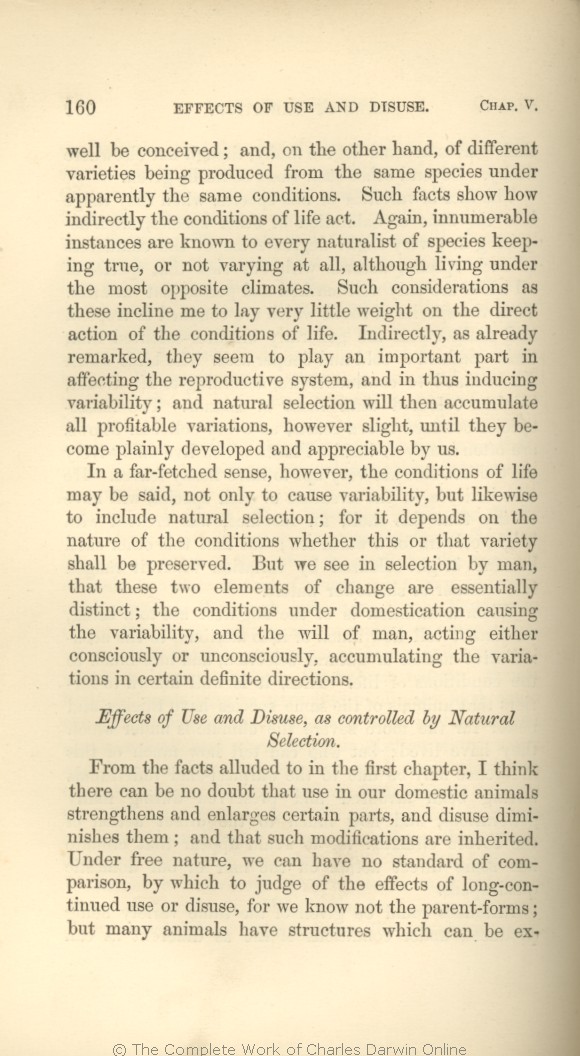well be conceived; and, on the other hand, of
different | different 1859 1860 1861 1866 | | dissimilar 1869 1872 |
| from 1859 1860 1861 1866 | | under apparently 1869 1872 |
| species under apparently the same 1861 1866 |
| species under the same 1859 1860 |
| external 1869 1872 |
| ..... 1860 1861 1866 | | must 1859 |
| naturalist 1859 1860 1861 1866 | | naturalist, 1869 1872 |
| to lay very little 1859 1860 1861 1866 |
| not to lay much 1869 |
| to lay less 1872 |
| action 1859 1860 1861 1866 1872 |
| and definite action 1869 |
| conditions of life. 1859 1860 1861 1866 |
| conditions of life; but I fully admit that strong arguments of a general nature may be advanced on the other side. 1869 |
| surrounding conditions, than on a tendency to vary, due to causes of which we are quite ignorant. 1872 |
|
|
In
a far-fetched sense, however, | a far-fetched sense, however, 1866 |
| one sense 1869 1872 |
| but 1866 1869 |
| either directly or indirectly, but 1872 |
| selection; 1866 1869 | | selection, 1872 |
| it depends on the nature of 1866 |
| OMIT 1869 1872 |
| whether 1866 | | determine whether 1869 1872 |
| be preserved. 1866 | | survive. 1869 1872 |
| we see in selection by man, that these 1866 |
| when man is the selecting agent, we clearly see that the 1869 1872 |
| essenitally 1866 | essenitally 1869 1872 |
| the conditions under domestication causing the variability, and 1866 |
| the conditions cause the variability; 1869 |
| variability is in some manner excited, but it is 1872 |
| acting either consciously or unconsciously, 1866 1869 |
| which 1872 |
| accumulating 1866 | | accumulates 1869 1872 |
| cretain 1866 | | certain 1869 1872 |
| definite 1866 | definite 1869 1872 |
| directions. 1866 |
| directions, and this answers to the survival of the fittest under nature. 1869 |
| directions; and it is this latter agency which answers to the survival of the fittest under nature. 1872 |
|
Effects
|
Effects
1866 1869 1872 | |
Effects
1859 1860 1861 |
|
of
1866 1869 1872 | |
of
1859 1860 1861 |
|
Use and Disuse, as controlled by Natural Selection. 1866 |
|
Use and Disuse
.—
1859 1860 1861 |
|
Use and Disuse, as controlled by Natural Selection
. 1869 |
|
the increased Use and Disuse of Parts, as controlled by Natural Selection
. 1872 |
|
From the facts alluded to in the first chapter, I think there can be
no | no 1866 1869 1872 | | little 1859 1860 1861 |
| strengthens 1859 1860 1861 1866 1869 | | has strengthened 1872 |
| enlarges 1859 1860 1861 1866 1869 | | enlarged 1872 |
| diminishes 1859 1860 1861 1866 1869 | | diminished 1872 |
| can 1859 1860 1861 1866 | can 1869 1872 |
| have 1859 1860 1861 1866 1869 | | possess 1872 |
| ex- plained 1866 | | explained 1859 1860 1861 1869 | | best explained 1872 |
|









